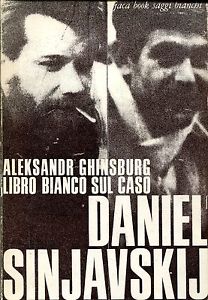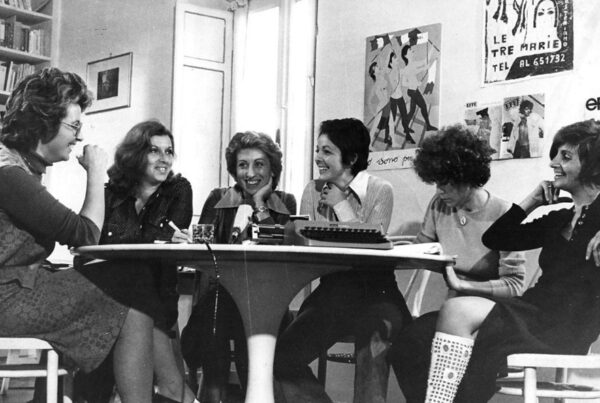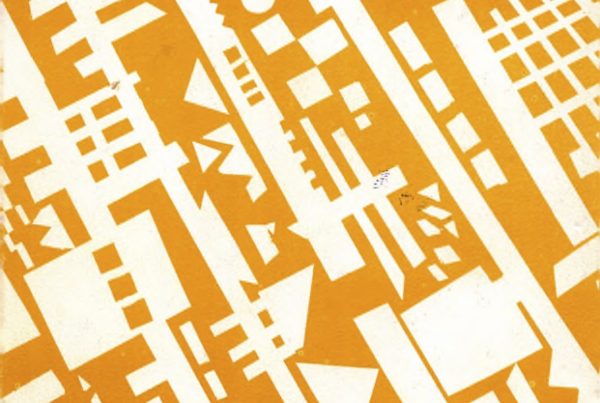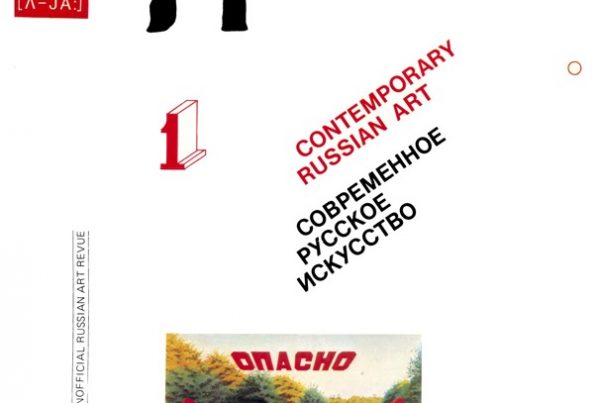
Cover of the Italian edition, 1967, ed. by Jaca Book.
Title:
Belaia kniga po delu A. Siniavskogo i Iu. Danielia [The White Book on the Siniavskii-Daniėl’ Case]
Author: Aleksandr Il’ich Ginzburg (1936-2002)
Years of editing: 1965–1967
First publication: 1967
Publisher: Possev-Verlag, Jaca Book
Place of publication: Frankfurt, Milano
First edition in Russian: 1967 (Posev)
Description:
The first Italian translation of The White Book on the Siniavskii-Daniėl’ Case, by Sergio Rapetti (under the pseudonym Nicola Sorin), was published in Milan by Jaca Book, and came out in the same year as the first tamizdat edition in Germany (Posev). The commitment of Jaca Book to disseminating the works of dissenting Soviet authors in Italy, especially in the 1960s and 1970s is indisputable. The previous year the publishing house had printed the chrestomathy Riviste clandestine dell’Unione sovietica (Clandestine magazines in the Soviet Union) and in 1968, after the White Book, it published the Italian version of the second issue of “Feniks 66“, whose editor-in-chief was Iu. Galanskov. In 1979, Jaca Book published several of the typewritten magazines of the 1960s including The Moscow Spring: Soviet Typewritten Magazines of the 1960s: Prose, Poetry, Civil Commitment at the Beginnings of Dissent (ed. Bukovskii et al. Milan, Jaca Book, 1979) as well as other titles on silenced, proscribed or censored literature from the USSR.
Before the first full Italian edition of the White Book was published, excerpts from the documents contained in the work had already been sent to the magazine “Tempo presente“, which had published them in 1966 (cf., for example, Documents. In defence of Siniavski, with an introduction by G. Herling, “Tempo presente”, 1966 (XI), 12, pp. 75-8, which reproduces the Letter of the art critic I. Golomshtok to the Supreme Court of the Russian Republic – early February 1966, cf. Ghinsburg 1967: 145-151). “Tempo presente” took a militant stance in defending Soviet dissenters and had given the Siniavskii-Daniėl’ case significant attention even before the White Book came out in Italy. In February 1966, it had published several reports on the trial (cf. Herling 1966: 2-4; Silone 1966: 4-6; Anonimo 1966: 6-7), which were widely read by Italian intellectuals, meaning that when Ginzburg’s work came out, its context was already understood by many of its readers.
Following these first almost simultaneous tamizdat editions, the book was circulated in other European countries and was in turn translated into English and French.
It was thanks to tamizdat circuits that information about the trial of Andrei Siniavskii and Iulii Daniėl’ became available, so that anyone interested in the case could gain objective documentation of the facts. In the USSR, information about the case in the USSR was mediated by newspapers closely linked to the Soviet regime, which did not provide reliable details about the indictments and the way the trial was conducted (which is why the “Khronika Tekushchikh sobytii“ was so important). The official press did all it could to condition public opinion, and the two dissident writers were attacked in the pages of the major newspapers as “slanderers” and “traitors to the fatherland”. The chapter in Siniavskii’s novel Goodnight! entitled Perevertyshi (Turncoats), like the caustic article written by the Soviet critic Eremin during the trial and published in “Izvestiia” on 12th January, became ironically autobiographical. During the 23rd conference of the CPSU in the same year Sholokhov, used the same term to refer to the two accused writers.
Most of the documents contained in Ginzburg’s work were published in the Soviet Union during perestroika, in 1989, in the collection Tsena metafory, ili Prestuplenie i nakazanie Siniavskogo i Daniėlia (The Price of Metaphor, or the Crime and Punishment of Siniavskii and Daniėl’), edited by E. Velinakov and published by The Book publishers in Moscow.
It is not easy to assess the impact of Ginzburg’s work in the West (in Italy, except for magazines such as “Tempo presente” the trial was only marginally covered in the press). However, it is certainly possible to discern the indirect effects of the European publication of the White Book in the Soviet Union. The book’s tamizdat editions favoured the formation of a critical attitude towards the regime and fueled the clandestine circulation of opinions counter to the official line, meaning that the author quickly became a target for retaliation by the authorities. In January 1968, the Moscow prosecutor’s office tried Ginzburg together with three other activists (Iu. Galanskov, A. Dobrovol’skii and V. Lashkova) in what came to be known as “the trial of the four”. Ginzburg was accused of compiling and publishing a censored text abroad, involvement in the samizdat almanac Feniks 66 (cf. Chiaromonte 1968: 2-3) and promoting a demonstration against the arrest of comrade Galanskov (cf. Galanskov 1968: 11). He was sentenced to five years’ imprisonment in the special correction camps, the Khrushchev ‘gulags’, in Mordovia.
Claudia Pieralli, Arianna Vivolo
[30th June, 2021]
Translation by Noemi Albanese
Bibliography
- Anonimo, Cronaca. Una perdita per la libertà, “Tempo presente”, XI.2 (1966): 6-7.
- Chiaromonte N., I condannati di Mosca, “Tempo presente”, XIII.1 (1968): 2-3.
- Galanskov Ju., Rivista sovietica non ufficiale: Feniks 66, trad. it. di N. Sorin, Milano, Jaca Book 1968.
- Ghinsburg A., Libro Bianco sul caso Daniel-Sinjavskij, Jaca Book, Milano 1968.
- Ginzburg A., Aleksandr Ginzburg: da “Sintaksis” al “Gruppo Helsinki”, in G. Nissim (ed.),Storie di uomini giusti nei Gulag, Mondadori, Milano 2004: 175-185.
- Herling G., Cronaca. La condanna di Sinjavskij eDaniel, “Tempo presente”, XI.2 (1966): 2-4.
- Silone I., Cronaca. Intorno al processo, “Tempo presente”, XI.2 (1966): 4-6.
- Velinakov E., Tsena metafory, ili Prestuplenie i nakazanie Siniavskogo i Daniėlia, Moskva 1989.
Sitography
- https://dissidenten.eu/laender/russland/biografien/alexander-ginsburg/, online (last accessed: 30/06/2021).
- https://www.lanuovaeuropa.org/personaggi-del-dissenso/2016/03/04/quel-ragazzo-che-lancio-il-samizdat/, online (last accessed: 30/06/2021).
To cite this article:
Claudia Pieralli, Arianna Vivolo, The White Book (A. Ginzburg), in Voci libere in URSS. Letteratura, pensiero, arti indipendenti in Unione Sovietica e gli echi in Occidente (1953-1991), a cura di C. Pieralli, M. Sabbatini, Firenze University Press, Firenze 2021-, <vocilibereurss.fupress.net>.
eISBN 978-88-5518-463-2
© 2021 Author(s)
Content license: CC BY 4.0




